Fiordland Photo: Is It Mystery Moose? Or Common Deer?
Posted by: Loren Coleman on May 30th, 2010
New Zealand has a long-standing manmade cryptid mystery.
A group of North American moose (Alces alces), ten in number, were released in 1910 in New Zealand. They are said to still roams parts of Fiordland. Until this week, the last confirmed contact with moose was in 1952, when one was shot. But people say they are present today, despite skeptical claims otherwise.
Ken Tustin and his wife Margie, late in 2008 and early in 2009, installed a dozen digital cameras in the bush between Wet Jacket Arm and Dusky Sound. Tustin guesstimates that a population of 20 moose could be living in the area in 2010, and he’s been trying to capture one on film.
Did he succeed recently?
Is this new trailcam photo proof?
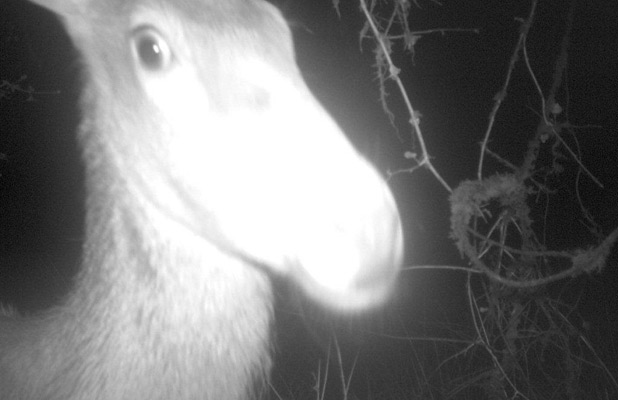
It could be a young moose, at least from my first hand experiences of seeing nearly a hundred different moose of all ages in the wild, in Maine and elsewhere in New England. ~ Loren Coleman, Director, International Cryptozoology Museum, Portland, Maine.
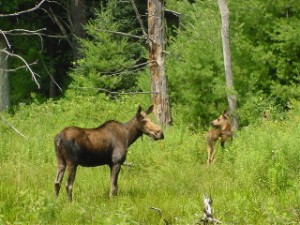
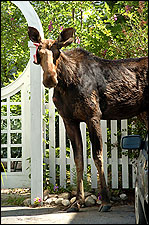
Technically moose (called elk in Europe) are deer, but when we are talking “moose” (above) versus “deer” (below), people are comparing two rather different groups of animals, of course.
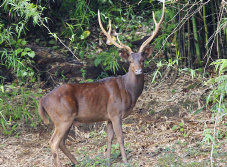
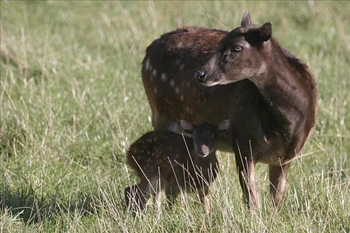
Ken Tustin is careful. He said last mid-week, when the news started circulating: “Between email and telephone calls, I’ve had about 30 people contact me. About a third say ‘Congratulations, you’ve got a moose’, and the other two-thirds say ‘Look, I don’t know. It’s probably a deer, but look at that muzzle’.”

+++++
Is it a moose? Is it a deer? Or is it an extremely lost miniature pony?
Veteran Otago moose-hunter Ken Tustin thinks he may have snapped a photograph of a juvenile moose in southwestern Fiordland.
The hulking animals have not been officially spotted in New Zealand for more than 50 years.
Mr Tustin, who first started tracking moose in the 1970s, said the photograph was taken by one of 13 cameras he had set up surrounded by triggers.
It was shot on March 7 in an area known as Herrick Creek, but was retrieved only a few days ago, Mr Tustin said.
When he viewed the images, he waded through thousands that showed only deer.
“But there was one photo that was strikingly different and it had me sitting back with my hair on end.”
The first sign it was different was the “horse-shaped face”, which contrasted with the dog-shaped face of a deer, he said.
However, the photo showed a broader neck than he would expect from a moose, and he suspected it might actually be a deer, he said.
“I think this will always be a ‘maybe’.”
It could not be a half-moose, half-deer because the two species did not interbreed, he said.
Most people regarded the last official sighting of a moose to have been from 1952, but he had documented more sightings since then, he said.
DNA testing on hair follicles found in 2001 and 2002 had proven to be from a moose, he said. He estimated a population of 20 moose could be wandering around the area – though that was a “total guess”.
– Southland Times, May 26, 2010, New Zealand.
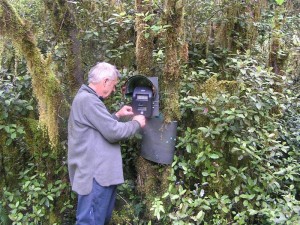
Ken Tustin checks a remote digital camera installed near Herrick Creek, Wet Jacket Arm, Fiordland, to detect moose. Photo by Marg Tustin.
Not to say it is related, but this is a milestone anniversary of the release of the moose, and a new book just came out.

A (Nearly) Complete History of the Moose in New Zealand by Ken Tustin has the unfortunate publishing date of April 1st, 2010, from Halcyon Press.
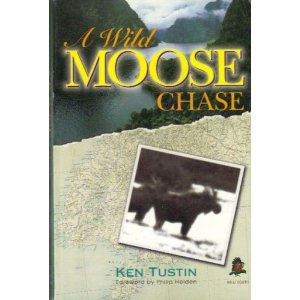
Tustin’s earlier book, A Wild Moose Chase, appeared in 1998.
One hundred years on and moose in Fiordland live on – well, according to a South Otago-based moose hunter anyway.
Ken Tustin, of Bull Creek, near Milton, is celebrating the 100- year anniversary of the release of moose in Fiordland today with a book that details evidence of moose from the area.
The book, A (nearly) complete history of the moose in New Zealand, details encounters with moose in the fiords and the many sightings of the animal by hunters, trampers, fishermen and lighthouse keepers.
The biologist had been collecting evidence and stories of moose in New Zealand for about 40 years and the book offered photo and DNA evidence from as recently as 15 years ago, he said.
“It was generally thought that the animals were extinct in the mid-30s but in the early 50s there were a number of individuals that shot and photographed the moose.
“So what it has is stories of people’s sighting or shooting or someone that has seen a skeleton of the moose as proof,” he said.
The stories about moose sightings, of which 60 were post-1960, had taken years to put together after tracking people down and then confirming their moose encounter story with a second source, Tustin said. “This book is firstly about moose, but it is also about a social history as it says what each person was doing down in the sounds at the same time.”
The book will be in Southland book stores by April 15.
~ Southland Times, April 9, 2010, New Zealand.
Thanks for a heads up from Tony Lucas.
About Loren Coleman
Loren Coleman is one of the world’s leading cryptozoologists, some say “the” leading living cryptozoologist. Certainly, he is acknowledged as the current living American researcher and writer who has most popularized cryptozoology in the late 20th and early 21st centuries.
Starting his fieldwork and investigations in 1960, after traveling and trekking extensively in pursuit of cryptozoological mysteries, Coleman began writing to share his experiences in 1969. An honorary member of Ivan T. Sanderson’s Society for the Investigation of the Unexplained in the 1970s, Coleman has been bestowed with similar honorary memberships of the North Idaho College Cryptozoology Club in 1983, and in subsequent years, that of the British Columbia Scientific Cryptozoology Club, CryptoSafari International, and other international organizations. He was also a Life Member and Benefactor of the International Society of Cryptozoology (now-defunct).
Loren Coleman’s daily blog, as a member of the Cryptomundo Team, served as an ongoing avenue of communication for the ever-growing body of cryptozoo news from 2005 through 2013. He returned as an infrequent contributor beginning Halloween week of 2015.
Coleman is the founder in 2003, and current director of the International Cryptozoology Museum in Portland, Maine.










Sure looks like a moose calf at first glance..
But I think that the lighting, the angle and the perspective of the camera could have a young New Zealand Wapiti. Sure would help if you could just see the ears. I think the muzzle on a young moose would be more
“fleshy”. Yet the glare of the flash is obscuring some of the nasal features, so I can’t be sure.
Whatever ever it is, it certainly looks like delicious “Great Hair Moehau” food. But thats another story.
http://www.truetravel.cz/jpg/jpg13/1343/vladka-and-deer-new-zealand_640x480.jpg
That definitely is no young moose! The head shape and snout is all wrong. If they suspect moose is still surviving down there, why do they not attempt to call during rut, if they speak moose that is. Calling during early summer or spring should bring out yearlings which at that time are curious at anything new. I speak moose after a life of moose hunting, it is not that difficult. You can get good calls on tape.
The animals also leave pellets on the ground. No pellets around, no moose any more.
I believe this is a very young moose. If you look at the second picture below the main photograph there is a distinct protusion of the snout that is a moose trademark. If the last record sightings of a moose were in the late fifties, here are three explanations:
1) One female survived and potentially mated with a neighbouring species creating a moose + ? hybrid OR
2) Moose populations in New Zealand remained elusive, avoiding all contact with humans OR
3) Someone imported a moose recently, to perhaps start a new population, and this is a photograph of one
I’m 50/50 on this one. Those trail cams have a wide angle lens. The subject of the photo is so close to the lens of the camera, that you would get distortion of the subject. You would get a broadening of the snout, just like you would get a big nose if the the subject were a human. That would explain why the neck proportion does not match for a moose but the head does.
I am leaning towards a deer at this point, but seriously, it could go the other way. If I must choose, I would say this is a deer and the resulting photo looks the way it does, due to a photographic anomaly created by the wide angle lens of the trailcam.
Like a number of commenters here, I too have lived in proximity to moose, and I can see where one would think that the snout on this specimen looks to be just a bit too fleshy to be that of the well recognized red-deer/wapiti which we know exist in abundance in that area. The other comments as to proportion of the neck or whatever details seem to present themselves also seem too vague to be determined with any accuracy especially since we don’t have a comparison by which we can judge or measure. I can attest to the fact that animals, even the size of moose can be very elusive, and having been down to NZ a few times I can also attest to the density and inpenetrability of fijordland’s alpine rainforest brush. Everthing adds up to an excellent reason to continue to search. I wouldn’t be surprised if a small population has lingered.
If you take the photo at face value, I’d say it’s a moose. And I’ve seen a lot of them also up close.
But let’s not forget there’s camera equipment between us and the motive, including a strong flash, perhaps distorting its facial features.
Moose and deer are not that difficult to tell apart. This is NOT a moose yearling. If it were a moose it had to have far more pronounced eye sockets/ and ridges. You can clearly see the nostrils of the trail cam animal, while a moose’s nostrils is positioned differently and their shapes are different too. The shape of the snout is too sleek to be moose. Check out the fur down the neck, that is no moose pelt. It is a curious Fiordland deer, even if it is very close to the trail cam.
The moose hunter, plus red deer hunter.
I’m pretty sure this is a deer. The muzzle being up so close and the bad lighting combined creates an optical illusion that it has a large muzzle like a mooses’. Plus, the neck seems too thin.
I first thought Moose calf because the muzzle is too broad for deer, but considering possible distortion I have to go with deer – especially because of one other point; no dewlap. Even a yearling would have a dewlap and a more proportioned snout, but there is nothing there, not even a tuft?